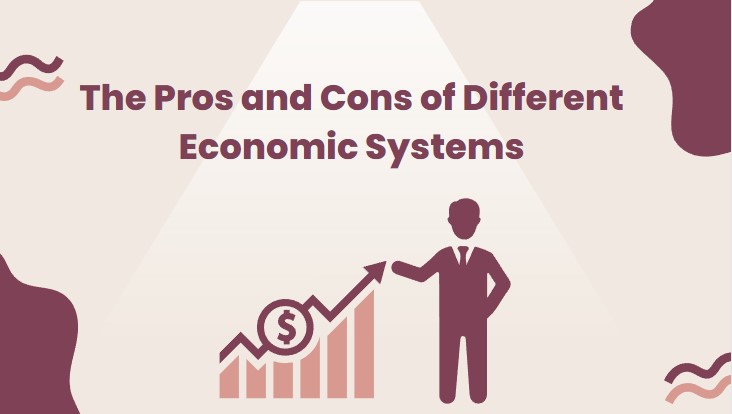The Pros and Cons of Different Economic Systems: Capitalism, Socialism, and Mixed Economies

Introduction
Economic systems are the means by which a society or government organizes the production and distribution of goods and services. There are several different types of economic systems in the world, each with their own set of benefits and drawbacks. In this article, we will examine the pros and cons of the three most common economic systems: capitalism, socialism, and mixed economies.
Understanding Capitalism: The Pros and Cons of a Market Economic System

Capitalism is an economic system in which the means of production are privately owned and operated for profit. The government plays a minimal role in regulating the economy and individuals are free to make their own economic decisions. This system is based on the principles of supply and demand, and market forces drive the economy. While capitalism has been a dominant economic system for the past few centuries, it remains a controversial and complex topic. In this article, we will examine the pros and cons of capitalism as an economic system.
The Basics of Capitalism
In a capitalist system, the ownership of the means of production, such as factories and businesses, is in the hands of private individuals or companies. These owners are driven by the profit motive and are free to produce and sell goods and services as they see fit. Prices are determined by the laws of supply and demand, and market competition ensures that goods and services are produced at the lowest possible cost.
The Pros of Capitalism
- Economic growth and development: Capitalism encourages innovation and competition, which leads to increased productivity and economic growth. This, in turn, leads to higher living standards and increased prosperity for society as a whole.
- Increased Efficiency: In a capitalist system, market forces drive resources to their most efficient uses. This leads to greater innovation and more efficient production methods, which ultimately benefits consumers.
- Individual freedom: Capitalism allows individuals to make their own economic decisions and pursue their own self-interest. This freedom encourages entrepreneurship and innovation, and can lead to a more dynamic and diverse economy.
The Cons of Capitalism
- Income inequality: Under capitalism, wealth and income are not distributed equally among individuals. This can lead to a widening gap between the rich and the poor and can undermine social cohesion.
- Lack of access to basic goods and services for some individuals: Capitalism prioritizes profit over meeting the basic needs of all individuals. This can lead to a lack of access to healthcare, education, and other essential services for those who cannot afford them.
- Lack of government regulation: Without government intervention, capitalism can lead to economic instability and financial crises. This can result in widespread suffering and hardship, particularly for those who are already vulnerable.
Capitalism in Practice
It’s worth noting that there are different variations of capitalism, such as laissez-faire capitalism and welfare capitalism. Laissez-faire capitalism is characterized by minimal government intervention and regulation, while welfare capitalism typically includes more government intervention to provide safety nets and other social welfare programs.
Capitalism is a complex and multifaceted economic system. It has the potential to drive economic growth and development, and can lead to higher living standards and increased prosperity for society as a whole. However, it also has its share of drawbacks, such as income inequality, lack of access to basic goods and services for some individuals, and lack of government regulation. Ultimately, the success of capitalism depends on the specific context and policies in place, and a balance must be struck between economic growth and social welfare.
Exploring Socialism: The Pros and Cons of a Collective Economic System

Socialism is an economic system in which the means of production are owned and controlled by the community or the state. The government plays a significant role in regulating the economy and redistributing wealth in order to achieve social and economic equality. While socialism is not as widely practiced as capitalism, it has been gaining popularity in recent years as a potential solution to the problems of inequality and poverty. In this article, we will examine the pros and cons of socialism as an economic system.
The Basics of Socialism
In a socialist system, the means of production, such as factories and businesses, are owned and controlled by the community or the state. The government regulates the economy to ensure that basic needs are met for all citizens and that wealth is distributed more equally. The goal of socialism is to create a more equal society with a more just distribution of resources.
The Pros of Socialism
- Reduced income inequality: Socialism aims to reduce the gap between the rich and the poor by redistributing wealth through progressive taxation and social welfare programs.
- Greater access to basic goods and services: Under socialism, the government is responsible for providing access to basic goods and services, such as healthcare and education, for all citizens.
- Social and economic equality: Socialism values equality and fairness above all else and aims to create a society where everyone has an equal opportunity to succeed.
The Cons of Socialism
- Reduced economic growth: Because the government has a large role in regulating the economy, there is less incentive for individuals to innovate and take risks. This can lead to slower economic growth and fewer job opportunities.
- Lack of individual freedom: In a socialist system, individuals have less freedom to make their own economic decisions and may be subject to government control.
- Inefficiency: Because the government controls the means of production, there is less competition and incentives to be efficient, which can lead to inefficiencies and in some cases shortages of goods and services.
Socialism in Practice
It’s worth noting that there are different variations of socialism, such as democratic socialism and authoritarian socialism. Democratic socialism is characterized by a strong welfare state and a mixed economy, while authoritarian socialism is characterized by a centrally planned economy and a lack of political freedom.
Socialism is an economic system that aims to create a more equal society with a more just distribution of resources. It has the potential to reduce income inequality and provide greater access to basic goods and services for all citizens. However, it also has its share of drawbacks, such as reduced economic growth, lack of individual freedom, and inefficiencies. Ultimately, the success of socialism depends on the specific context and policies in place, and a balance must be struck between social welfare and economic growth.
Understanding the Benefits and Drawbacks of Mixed Economies

A mixed economy is an economic system that combines elements of both capitalism and socialism. The government plays a role in regulating the economy and providing for the welfare of citizens, while private enterprise drives economic growth and innovation. This type of system is often thought of as a middle ground between capitalist and socialist economies. In this article, we will examine the pros and cons of mixed economies.
The Basics of Mixed Economies
In a mixed economy, the government and private enterprise both play a role in the economy. The government provides for the welfare of citizens through social programs and regulations, while private enterprise drives economic growth and innovation through competition and the profit motive. This type of system aims to balance economic growth and social welfare.
The Pros of Mixed Economies
- Flexibility: A mixed economy allows for a greater degree of flexibility in economic policy, allowing for adjustments to be made as needed to address changing economic conditions.
- Economic stability: The government’s role in regulating the economy can help to stabilize the economy and prevent excessive booms and busts.
- Greater access to basic goods and services: The government’s role in providing for the welfare of citizens can ensure that basic needs are met for all citizens.
The Cons of Mixed Economies
- Bureaucratic inefficiencies: The government’s role in regulating the economy can lead to bureaucratic inefficiencies and slow decision-making.
- Income inequality: The private enterprise component of a mixed economy can lead to income inequality, as those with more resources are better able to take advantage of economic opportunities.
- Limited government control: The government’s role in a mixed economy is limited, which may not be sufficient to address certain social and economic issues.
Mixed Economies in Practice
It’s worth noting that there are different variations of mixed economies and the specific policies and regulations in place can greatly impact the effectiveness of the system. Some countries, like the United States, have a more capitalist-leaning mixed economy, while others, like Sweden, have a more socialist-leaning mixed economy.
A mixed economy is an economic system that combines elements of both capitalism and socialism. It aims to balance economic growth and social welfare. The government’s role in regulating the economy can help to stabilize the economy and provide for the welfare of citizens, but it can also lead to bureaucratic inefficiencies and slow decision-making. Income inequality is also a potential drawback. Ultimately, the success of a mixed economy depends on the specific policies and regulations in place and the balance struck between private enterprise and government control.
Freedom and social welfare, and the efficient allocation of resources. It’s worth noting that no economic system is perfect and each one has its own set of challenges. Mixed economies, in particular, require careful balancing of government intervention and market forces. It’s also important to remember that economic systems are not static and can evolve over time. It’s important for countries and societies to continuously evaluate and adapt their economic systems to best meet the needs of their citizens and the changing global economic environment.
Conclusion:
Economic systems are complex and multifaceted. Each system has its own set of pros and cons, and choosing the right system for a country or society depends on a variety of factors. Ultimately, the best economic system is one that strikes a balance between economic growth and stability, individual.



